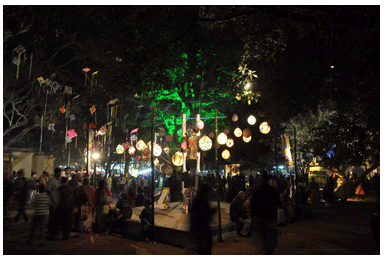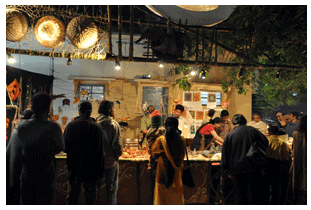- There's room, enough room for change, always...
- Guest Editor’s Column
- Nandan Mela
- Shifting Trends
- Hollywood Regency Furniture
- Hard Talk
- The other side
- Market Insight
- Artist Index and Statistics
- Auction Reports
- Creative Impulse
- Theatre Review
- Love and Hate Spinning a Touchy Tale of Identification
- The winning qustient : SRK or AMIR?
- In the News
- Book Review
- The month that was
- East City Kolkata: Before the campaign
- Stains on my Chintz
- Rythmic Significance
- Logged
- A retrospective and a requiem
- Size matters or does It?
- S.H. Raza
- Malevich matters and other shutters
- B-Swarga
- Black Candy
- Tryst with modernity & tradition
- Simultaneous release of magazines
- Photo Feature
- Different hues of Aakriti
ART news & views
Nandan Mela
Volume: 2 Issue No: 2 Month: 3 Year: 2010
In the annual cycle of fairs and secular festivals of Santiniketan, Nandan Mela, the art fair, organized by Kala Bhavana in its campus, on the first and second December each year, to commemorate the birth anniversary of the school's pater figure-- Nandalal Bose, following on the 3rd December, is the youngest of such fairs and festivals of Santiniketan.  If in the conception of Nandan Mela, there was any intention of exposing art to the local community and making some of it available at affordable price to the community (at its decent average level), it was a carry forward from the art-centric functions of the older Poush Mela and Anandamela, which the initiators of Nandan Mela whole heartedly approved, but did not prioritise. For the conceivers and initiators, Nandan Mela was an exigency driven Endeavour of building up a students' welfare emergency fund for the Kala-Bhavana students, away from the bureaucratic control of the university administration. The teacher of sculpture Ajit Chakraborty who was previously with the Faculty of Fine Arts of the MS University of Baroda, proposed the replication of their model of art fair for raising funds, which immediately received enthusiastic support from Somnath Hore and Dinakar Kowshik, the two leaders of Kala Bhavan then. The Baroda art fair, incidentally, was initiated by Sankho Chaudhury and K.G.Subramanyan, the two distinguished alumni of Kala Bhavana, with two Santiniketan models in mind. It came back to Santiniketan in 1973, after a full circle, as a fully art fair. It needs to be noted that these art fairs chronologically preceeded the postmodernist art fairs, supposedly designed to find an alternative to commercial market circuit, comprising galleries, dealers and clients etc.(much of these publicized endeavours, after all, turned out to be strategies for market expansion). Although the initiators of both the Baroda Fine Arts Faculty fair and the Nandan Mela had no conscious intention of finding an alternative to the normal art market circuit (simply for the fact that there was no art market, in India, at that period, worth the name), the initiators had felt the need of reaching out to wider public, by offering less expensive, non-formal, somewhat functional and a little more craft- oriented objects, at what the community would consider as affordable price. This kind of an understanding made these fairs different from the latter day mega-global art fairs. Nandan Mela achieved the goal of building up a sizeable students welfare fund within a few years. In the process, there was an unintentional but laudatory fall-out. In the short span of time, of around a month, given for the preparation of objects for the fair, the teachers and the students learnt to work intensely, at a quick pace, in groups, with wish to show off their innovativeness. Kala Bhavan unwittingly, thus began to offer opportunities of frenzied work in festive atmosphere which very few educational institutions could think of.
If in the conception of Nandan Mela, there was any intention of exposing art to the local community and making some of it available at affordable price to the community (at its decent average level), it was a carry forward from the art-centric functions of the older Poush Mela and Anandamela, which the initiators of Nandan Mela whole heartedly approved, but did not prioritise. For the conceivers and initiators, Nandan Mela was an exigency driven Endeavour of building up a students' welfare emergency fund for the Kala-Bhavana students, away from the bureaucratic control of the university administration. The teacher of sculpture Ajit Chakraborty who was previously with the Faculty of Fine Arts of the MS University of Baroda, proposed the replication of their model of art fair for raising funds, which immediately received enthusiastic support from Somnath Hore and Dinakar Kowshik, the two leaders of Kala Bhavan then. The Baroda art fair, incidentally, was initiated by Sankho Chaudhury and K.G.Subramanyan, the two distinguished alumni of Kala Bhavana, with two Santiniketan models in mind. It came back to Santiniketan in 1973, after a full circle, as a fully art fair. It needs to be noted that these art fairs chronologically preceeded the postmodernist art fairs, supposedly designed to find an alternative to commercial market circuit, comprising galleries, dealers and clients etc.(much of these publicized endeavours, after all, turned out to be strategies for market expansion). Although the initiators of both the Baroda Fine Arts Faculty fair and the Nandan Mela had no conscious intention of finding an alternative to the normal art market circuit (simply for the fact that there was no art market, in India, at that period, worth the name), the initiators had felt the need of reaching out to wider public, by offering less expensive, non-formal, somewhat functional and a little more craft- oriented objects, at what the community would consider as affordable price. This kind of an understanding made these fairs different from the latter day mega-global art fairs. Nandan Mela achieved the goal of building up a sizeable students welfare fund within a few years. In the process, there was an unintentional but laudatory fall-out. In the short span of time, of around a month, given for the preparation of objects for the fair, the teachers and the students learnt to work intensely, at a quick pace, in groups, with wish to show off their innovativeness. Kala Bhavan unwittingly, thus began to offer opportunities of frenzied work in festive atmosphere which very few educational institutions could think of.
Come post-1991 liberalized economy, triggering an unprecedented boom in Indian art market. The supply hungry art distributors from all over the country swooped down upon Nandan Mela as the cheapest source of art anywhere, where K.G. Subramanyan and Somnath Hore, Jogen Chowdhury and Sarbari Roychoudhury, Sanat Kar and Suranjan Basu's work could be had for dirt cheap prices.  The supply hungry traders and collectors alike from every part of the country would mop up everything worth taking within no time. No measure to control and regulate, no amount of rationing could prevent the clever traders from efforts to corner the supply at the earliest opportunity. It was soon found out that the donated Jogens and Subrahmanyans,Somnath Hores and Sanat Kars, picked up in the Mela, at one-third their market price, were selling at three times their Mela price the next week and five times their Mela price the following month, in the ever burgeoning markets of Mumbai, Delhi, Bangaluru and Kolkata. To protect their market interest, the artists were constrained to raise the sale price of the work they donated for the welfare fund. Such raising of prices started alienating the local community who were once used to getting gifts of art objects from the Santiniketan artists for decorating their newly constructed pricey homes.
The supply hungry traders and collectors alike from every part of the country would mop up everything worth taking within no time. No measure to control and regulate, no amount of rationing could prevent the clever traders from efforts to corner the supply at the earliest opportunity. It was soon found out that the donated Jogens and Subrahmanyans,Somnath Hores and Sanat Kars, picked up in the Mela, at one-third their market price, were selling at three times their Mela price the next week and five times their Mela price the following month, in the ever burgeoning markets of Mumbai, Delhi, Bangaluru and Kolkata. To protect their market interest, the artists were constrained to raise the sale price of the work they donated for the welfare fund. Such raising of prices started alienating the local community who were once used to getting gifts of art objects from the Santiniketan artists for decorating their newly constructed pricey homes.
The over inflated booming art market finally burst in mid-2008. 2009 was a bleak year. Gone were the swooping crowd of trader families and NRI families and moneyed collectors from big cities, missing were the jostling crowd of specifically employed local young men and chauffeurs in the ques of intending purchasers of Jo and KG. Sanity and joy returned to Nandan Mela of 2009, even if some mirth and excitement were missing.
But the greatest and the most significant event of the 2009 Nandan Mela has been, coinciding of putting of finishing touches and opening to view of K.G. Subramanyan's new black-and white mural,  on a building in Kala Bhavana campus. Ten years ago, Subramanyan had painted a mural in black-and white on the three exterior elevations of a twenty-five feet high building, with an improvised kind of synthetic tempera. It was not meant to stay long. Over the years it faded with bits of chipping. At the age of eighty-six Subramanyan came back to re-do the wall painting all anew on freshly done plaster. Went up and down the scaffolding, four times a day, and finished the new painting within a month, to coincide with Nandan Mela. It turned out to be a wonder. Proper lighting turned the building into the festival icon.
on a building in Kala Bhavana campus. Ten years ago, Subramanyan had painted a mural in black-and white on the three exterior elevations of a twenty-five feet high building, with an improvised kind of synthetic tempera. It was not meant to stay long. Over the years it faded with bits of chipping. At the age of eighty-six Subramanyan came back to re-do the wall painting all anew on freshly done plaster. Went up and down the scaffolding, four times a day, and finished the new painting within a month, to coincide with Nandan Mela. It turned out to be a wonder. Proper lighting turned the building into the festival icon.
This gave this scribe an idea. Why does not the Kala Bhavana authority think of a mural or free standing public sculpture or a relief, as a project work, every year, and finish it to coincide with Nandan Mela. The building need not always be on in Kala Bhavana complex. If it is away from the Kala Bhavana campus, the authorities can also think of shifting the Mela site to around that building, with new mural or a relief or a sculpture in front. This way the Kala Bhavana fair will become a Visva Bharati fair. With it the authorities can think of offering more non-formal and affordable user-friendly art-and-craft objects. Making the Sriniketan art craft-set-up a participant may produce desired result.